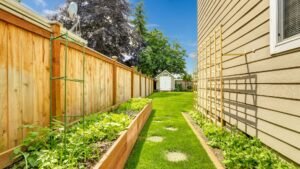Welcome to your ultimate guide on how to build a deck with a roof in New Zealand! In this article, we’ll walk you through everything you need to know to create a functional, beautiful outdoor space that complements your home and lets you enjoy the great Kiwi outdoors, no matter the weather. Whether you’re looking to extend your living area, protect your deck from rain, or simply create a shaded space for relaxing and entertaining, adding a roof to your deck can be a game-changer. From understanding local building codes to choosing materials and constructing your deck step by step, we’ve got you covered. Let’s dive in!
To build a deck with a roof in New Zealand, start by checking local building codes and obtaining the necessary permits. Plan your deck design, including choosing materials like treated timber and deciding on roof styles such as flat or gable. Prepare the site, lay the foundations, construct the deck frame, and install the decking boards. Finally, build the roof frame, secure the rafters, and install roofing materials. Waterproofing and regular maintenance will ensure long-term durability. For complex designs, consider hiring a professional to ensure compliance with NZ regulations.
Table of Contents
Understanding Building Codes And Permits In New Zealand
When you’re planning to build a deck with a roof in New Zealand, one of the first and most important steps is to understand the building codes and permits required. Navigating this process properly is essential to ensure your project meets legal standards and avoids future complications. Here’s an in-depth look at why building codes matter, what permits you’ll need, how to check site regulations, and where to find useful resources.
Why Building Codes Matter
Building codes are designed to ensure that all structures, whether residential or commercial, meet safety, durability, and environmental standards. In New Zealand, the Building Act 2004 governs all building work, with the aim of making buildings safe and healthy to live in, as well as durable over time. When it comes to building a deck with a roof, adhering to the building codes is especially crucial because improper construction could lead to structural failures, water damage, or safety hazards.
By complying with New Zealand’s building regulations, you not only ensure that your deck is safe for use, but also avoid penalties or orders to remove non-compliant structures. It’s also worth noting that if you ever plan to sell your home, non-compliance could become an issue, as prospective buyers or their solicitors may request proof of building consent for any major alterations.
What Permits You Need
Before you can start construction, you’ll need to check if your project requires a building consent. In New Zealand, a building consent is an approval issued by your local council that confirms your proposed construction work complies with the Building Code. For decks, especially those with roofs, permits are often required due to the structural complexities involved.
If your deck is more than 1.5 meters off the ground, or if you’re adding a roof that changes the footprint of your home, you will most likely need a building consent. Roofed decks are considered more complex than standard, uncovered decks because they involve additional structural considerations, such as ensuring the roof can withstand wind and weather conditions. It’s also essential to confirm that your design complies with standards for things like drainage and waterproofing, as poorly designed roofs can cause long-term issues like leaks or mold.
To get started, consult your local council or visit their website to review the specific requirements for building consent in your area. Many councils in New Zealand, such as Auckland Council, provide detailed guidelines on their websites, including what paperwork you need to submit and the timeline for approval.
Checking Site Regulations
When building a deck with a roof, site-specific regulations also come into play. These regulations help ensure that your structure is not only safe but also respectful of the surrounding environment and community. Here are a few factors to consider.
- Boundary Lines: Different regions have rules about how close your deck can be to property boundaries. In some cases, you might need to maintain a certain distance between your deck and neighboring properties to avoid encroaching on their space or causing issues with drainage.
- Height Restrictions: Decks and roofs that exceed certain heights might require additional consent, especially if they obstruct views or create privacy concerns for neighbors. Always check the height limits in your region to avoid having to alter or remove your structure later.
- Safety Codes: If your deck is more than 1 meter above the ground, you’ll need to install a balustrade or handrails to prevent falls. Additionally, the roof needs to be designed to withstand the unique weather conditions in your area, including wind, rain, and potentially snow in certain parts of New Zealand.
By thoroughly checking these regulations before you start building, you can ensure your project goes smoothly without the risk of fines or delays.
Useful Resources
To help you navigate the building process, there are several key resources available. The New Zealand Building Code is the primary document governing construction in the country. It sets the minimum performance standards for all buildings, ensuring they are safe, healthy, and durable. You can access the Building Code through the Ministry of Business, Innovation and Employment (MBIE) website.
Additionally, most local councils offer comprehensive guides and resources online, including step-by-step instructions on applying for building consent. For example, Auckland Council and Wellington City Council both provide user-friendly portals where you can submit applications, track progress, and even find licensed professionals if you need assistance with your project.
By taking the time to understand these building codes, permits, and regulations, you’ll set your deck project up for success and ensure that your outdoor space is not only beautiful and functional but also safe and compliant with New Zealand law.

Planning Your Deck With Roof
Building a deck with a roof is a rewarding home improvement project that can enhance your outdoor living experience, but successful planning is essential for achieving a functional and aesthetically pleasing result. In this section, we’ll cover how to plan your deck, from defining its purpose to selecting materials and setting a realistic budget.
Define the Purpose
Before you dive into construction, take the time to clearly define the purpose of your deck. Ask yourself how you want to use this outdoor space. Is it primarily for entertaining guests, dining outdoors with family, or simply as a peaceful spot for relaxation? Defining the purpose will shape the design and functionality of your deck. For example, a deck meant for entertaining might require more space for seating and tables, while a relaxation-focused deck could benefit from built-in seating or space for lounge chairs. By having a clear goal in mind, you can make informed decisions about the layout, size, and design elements of both the deck and its roof.
Design Considerations
Once you’ve defined the purpose, it’s time to think about the design. A key part of planning is choosing the right roof style for your deck. Some common options include.
- Flat roof: Ideal for a modern, minimalist look, flat roofs are easy to construct and provide simple coverage. However, they require proper drainage planning to prevent water buildup.
- Gable roof: A more traditional style, gable roofs have two sloping sides that create a triangular peak. They’re great for maximizing headroom and allowing better airflow, making them a popular choice for covered decks in areas with heavy rainfall.
- Skillion roof: Known for its angled, single-pitch design, a skillion roof adds a contemporary edge to outdoor spaces. It’s easier to build than a gable roof and works well for homes with modern architectural styles.
- Pergola: If you’re looking for a partially covered option, a pergola might be right for you. With its open slats, it offers a balance between shade and sunlight, providing a more natural, airy feel.
When it comes to materials, you’ll want to select options that complement both the roof and the decking. For the deck itself, materials like pine (affordable and durable when treated), composite decking (low-maintenance and eco-friendly), or hardwood (premium durability and appearance) are all excellent choices. For roofing, materials like timber (for a rustic look), steel (for durability and weather resistance), or polycarbonate sheets (lightweight and effective at blocking UV rays) are common options. Each material has its pros and cons, so consider factors like climate, durability, and maintenance needs when making your decision.
Integration with Your Home
To create a seamless extension of your living space, your deck and roof design should blend harmoniously with the existing architecture of your home. Pay attention to the lines, materials, and colors already in use. For example, if your home has a modern design with clean lines and neutral tones, a skillion roof paired with composite decking could continue that sleek look outdoors. On the other hand, a more traditional home with warm wood tones might benefit from a gable roof and timber decking to maintain cohesion between indoor and outdoor spaces. You’ll also want to think about how the deck connects to your yard or garden. Incorporating landscaping around the deck or building steps that transition naturally into the surrounding terrain can create a smooth flow between the indoor and outdoor environments.
Budgeting
Setting a realistic budget is a crucial step in planning your deck with a roof. There are several factors to account for, and it’s important to avoid underestimating costs. First, consider the cost of materials—decking timber, roofing materials, fasteners, and sealants all add up. Premium materials like hardwood or composite decking will be more expensive than basic pine, and roofing materials like metal or polycarbonate may come at a higher price than simpler options.
Next, factor in labor costs if you plan to hire professionals. Skilled labor for deck building and roofing can vary in cost, and some elements like complex roofing structures or large decks will increase those expenses. It’s worth obtaining multiple quotes from local contractors to compare pricing and expertise before committing to a builder.
Finally, don’t forget about permit fees and compliance costs. In New Zealand, you’ll likely need a building permit for any deck with a roof, and meeting local building codes is essential. Check with your local council to understand the regulations and associated costs, which can vary by region.
By planning carefully and considering all aspects—purpose, design, integration with your home, and budgeting—you’ll set the stage for a successful deck and roof project that enhances your home and lifestyle.

Tools And Materials Needed For Building A Deck With A Roof In New Zealand
When embarking on a deck-building project, having the right tools and materials on hand is essential for both efficiency and quality. This section will walk you through everything you’ll need to get the job done. Whether you’re a seasoned DIY enthusiast or new to construction, this guide ensures you’re well-prepared before you even pick up a hammer. Let’s dive into the key tools, materials, and safety gear necessary for building a deck with a roof.
Essential Tools
Building a deck with a roof requires a variety of tools that will help you handle everything from cutting timber to ensuring the structure is level and secure. Here’s a rundown of the essential tools you’ll need to have in your toolbox.
1. Circular Saw or Handsaw: A circular saw is essential for cutting decking boards, posts, and beams to the required lengths. For smaller cuts, a handsaw will suffice, though a circular saw will speed up the process.
2. Power Drill and Driver: A power drill is vital for making holes for screws and bolts, and a driver attachment will help secure fasteners tightly. For a project this size, a cordless drill with extra battery packs is ideal to avoid interruptions.
3. Tape Measure: Accuracy is crucial when cutting and placing timber. A sturdy tape measure ensures that you get precise measurements for your decking boards, posts, and roof framing.
4. Spirit Level: A spirit level is essential for ensuring that both your deck and roof are perfectly horizontal or vertical. Using this tool throughout the build prevents unevenness, which could lead to structural issues or water pooling on the roof.
5. Hammer and Nails: A good hammer will be required for securing nails, but don’t forget to have a range of nail sizes available. While screws are often preferable for decking due to their durability, nails may be used for smaller tasks or aesthetic finishes.
6. Post Hole Digger or Auger: If you’re setting posts for the deck, you’ll need a post hole digger or an auger to create stable foundations for your support beams. These tools make digging the required depth much easier than using a shovel alone.
7. Square and Pencil: A carpenter’s square ensures that your cuts are straight and your angles are accurate, while a pencil lets you mark your measurements precisely.
8. Wrench and Socket Set: When installing bolts or larger fasteners, a wrench or socket set will allow you to tighten them properly, ensuring that the structure remains strong and secure.
Materials Checklist
Once you have the right tools, gathering the correct materials is the next step. Building a deck and roof requires a specific set of materials to ensure the structure is safe, sturdy, and weather-resistant. Here’s what you’ll need.
1. Decking Timber: Treated pine or hardwood like Kwila is commonly used for decking in New Zealand due to its durability and resistance to rot. The size and amount of decking boards will depend on the size of your deck, but always order a little extra to account for cutting errors or future repairs.
2. Roofing Material: For the roof, materials like corrugated metal, polycarbonate sheets, or treated timber slats are popular. Metal roofing is durable and great for water runoff, while polycarbonate allows natural light to pass through. Consider the aesthetic and functional qualities of the material based on your climate and design preferences.
3. Posts, Beams, and Joists: Your deck and roof will rely on sturdy support posts, beams, and joists. Treated timber is ideal for this purpose. Posts are the vertical supports that hold the deck and roof in place, while beams and joists form the horizontal framework that carries the weight of the structure.
4. Nails and Screws: It’s crucial to use galvanized or stainless-steel nails and screws to prevent rust, especially since New Zealand’s coastal areas can be particularly corrosive. You’ll need a variety of sizes depending on what part of the deck or roof you’re working on.
5. Concrete or Post Anchors: For secure foundations, you’ll either need concrete to set your posts or metal post anchors that attach directly to the deck base. Concrete footings provide long-lasting stability, especially for larger decks.
6. Flashing and Gutter Materials: To prevent leaks where the roof meets your house or the deck structure, flashing (usually metal strips) is required. Additionally, if you want to channel rainwater properly, guttering systems are a must.
7. Deck Stain or Sealant: To protect your deck from the elements, a quality deck stain or sealant will be needed. This not only enhances the appearance of the wood but also helps it resist moisture, UV rays, and general wear and tear.
Safety Gear
Safety should never be overlooked during any construction project, particularly one involving tools, heavy materials, and height. Here’s the safety gear you’ll need to keep yourself protected while building your deck with a roof.
1. Safety Goggles: Always wear goggles to protect your eyes from sawdust, debris, or splinters when cutting timber or working overhead.
2. Work Gloves: A durable pair of gloves will protect your hands from cuts, splinters, and general wear, as well as give you a better grip on tools and materials.
3. Hearing Protection: Power tools like saws and drills can be loud, especially if you’re working in a confined space. Earplugs or earmuffs will help protect your hearing from prolonged exposure to these high noise levels.
4. Dust Mask or Respirator: When sawing treated timber or sanding surfaces, harmful dust can become airborne. A dust mask or respirator will prevent you from inhaling these fine particles, protecting your respiratory health.
5. Hard Hat: If you’re working under a roof structure or lifting heavy beams, a hard hat can protect you from potential head injuries.
6. Steel-Toe Boots: Construction can involve lifting heavy materials, so wearing steel-toe boots will protect your feet from injuries caused by dropping tools or timber.
By ensuring that you have the right tools, materials, and safety gear in place, you’ll be setting yourself up for a successful and smooth deck-building experience. With proper preparation, you’ll save time, avoid costly mistakes, and most importantly, complete a project that’s both beautiful and built to last.
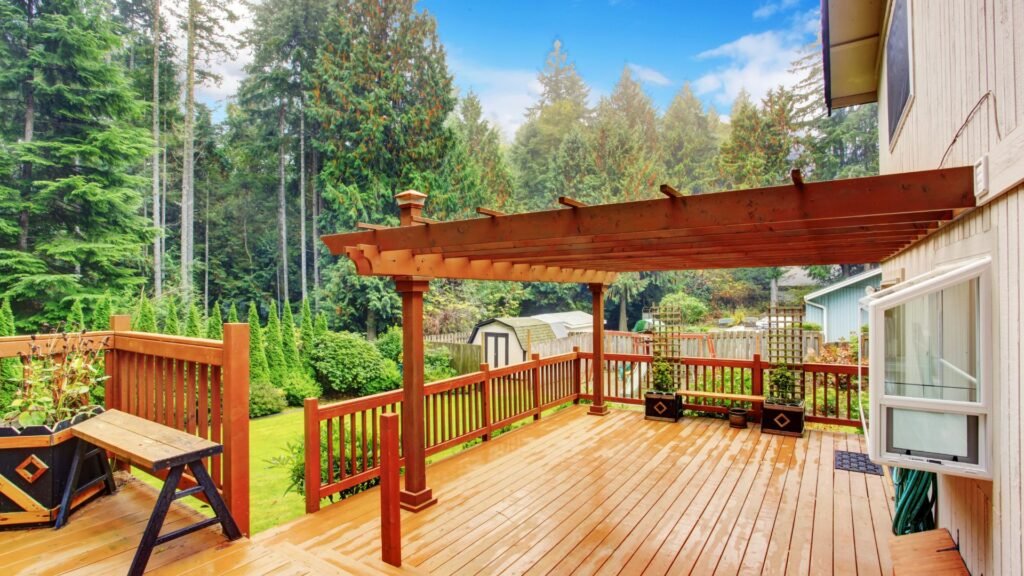
Step-By-Step Guide To Building A Deck With A Roof
Building a deck with a roof is a great way to expand your outdoor living space and add value to your home. Whether you’re a DIY enthusiast or hiring professionals, following these detailed steps will help ensure a durable, long-lasting deck that suits New Zealand’s unique climate. This guide walks you through each phase of the project, from site preparation to roofing installation, with practical tips to help you avoid common mistakes.
Step 1: Preparing the Site
The first step in building any deck is preparing the site. This might seem straightforward, but it’s crucial for the long-term stability and success of your deck.
- Clearing the Area: Start by clearing the ground where your deck will be located. Remove any vegetation, rocks, or debris that could interfere with the foundations or cause future drainage problems. Ensure there are no underground utilities in the area before digging.
- Leveling the Ground: Once the area is clear, use a level to ensure the ground is even. An uneven surface can lead to structural issues over time, such as sloping or water pooling. If the ground is sloped, you may need to build up certain areas with gravel or excavate others to achieve a flat base.
- Ensuring Proper Drainage: Drainage is a critical aspect, especially in New Zealand’s wet conditions. Without proper drainage, water can collect under the deck, leading to rot, mold, and structural damage. To prevent this, make sure the site is slightly sloped away from the house or add a gravel layer under the deck to aid in water drainage.
Step 2: Laying the Foundations
The foundation of your deck is essential for its stability and durability. The choice of footings will depend on your site conditions, deck height, and local building codes.
- Options for Footings: In New Zealand, two common types of footings are used: concrete and pile footings. Concrete footings provide a solid, long-lasting base and are ideal for decks that will support heavy loads or be used frequently. Pile footings, on the other hand, are faster to install and work well for smaller or low-level decks.
- Proper Spacing and Alignment: Once the footings are in place, ensure that they are evenly spaced and aligned correctly. Incorrect spacing can result in uneven weight distribution, which can cause parts of the deck to sag or become unstable. Typically, footings are spaced about 1.8 meters apart, but this can vary based on the deck’s size and load requirements.
Step 3: Building the Deck Frame
The deck frame forms the backbone of your structure, so it’s vital to construct it correctly to ensure the deck’s stability and longevity.
- Constructing the Framework Using Joists and Beams: Begin by laying out your joists and beams according to the deck’s design. Joists run parallel to the house and are supported by beams, which run perpendicular. Use pressure-treated timber to prevent rot and insect damage, especially in areas prone to moisture.
- Importance of Correct Spacing: Proper spacing of joists is critical for structural integrity. For a typical residential deck, joists are usually spaced 400mm to 600mm apart. Ensuring consistent spacing prevents boards from warping and keeps the deck surface level.
- Securing the Frame to the House (if applicable): If your deck is attached to the house, it’s important to securely fasten the frame to the structure using galvanized lag bolts or anchors. This not only ensures stability but also helps distribute the weight of the deck evenly.
Step 4: Installing the Deck Boards
Once the frame is secure, it’s time to install the decking boards. This step is crucial for both the appearance and functionality of your deck.
- Best Practices for Laying Deck Boards: Lay your deck boards perpendicular to the joists, leaving a small gap (around 3-5mm) between each board. This gap allows for natural expansion and contraction due to weather changes, preventing warping and cracking.
- Securing Boards: Use stainless steel or galvanized screws to secure the boards, as these materials resist corrosion and rust. Screws provide a more secure hold than nails, reducing the risk of boards loosening over time.
- Tips for Avoiding Common Mistakes: One common mistake is uneven spacing between boards, which can lead to aesthetic and structural problems. Use spacers to ensure even gaps throughout the deck. Additionally, avoid over-tightening screws, as this can cause the wood to crack over time.
Step 5: Constructing the Roof Frame
Adding a roof to your deck not only provides shelter but also extends the usability of the space, making it a year-round feature.
- Choosing the Right Roof Pitch for New Zealand’s Weather: The roof’s pitch is crucial for managing rain and wind. In New Zealand, a steeper pitch (around 15 to 30 degrees) is ideal, as it allows rainwater to run off quickly, preventing water from pooling and damaging the structure.
- Installing Rafters, Beams, and Supports Securely: The roof frame consists of rafters and beams that provide structural support. Rafters should be spaced correctly (around 600mm apart) to distribute the weight of the roof evenly. Ensure that all connections are secure using brackets, bolts, and ties that are weather-resistant.
- Considerations for Gutters and Downpipes: Proper rain management is essential, especially in New Zealand’s variable climate. Install gutters along the edge of the roof and downpipes to direct water away from the deck and house foundation. This prevents water damage and flooding under the deck.
Step 6: Roofing Installation
The final step in building your deck with a roof is installing the roofing material. The choice of roofing not only affects the deck’s appearance but also its durability and weather resistance.
- Options for Roofing Materials: In New Zealand, popular roofing materials include polycarbonate, metal sheets, and timber cladding. Polycarbonate is lightweight, durable, and allows natural light to filter through, making it a great option for decks. Metal roofing is strong, long-lasting, and ideal for areas prone to heavy rain or wind. Timber cladding adds a natural aesthetic but requires more maintenance.
- Insulation Considerations: If you plan to use the deck year-round, especially in colder climates, consider adding insulation to the roof. Insulation helps maintain comfortable temperatures and reduces noise from rain.
- Finishing Touches Like Painting or Staining: After the roof is installed, protect it from the elements by applying a weatherproof coating, such as paint or stain. Not only does this enhance the roof’s longevity, but it also adds to the overall aesthetic of the space. Choose finishes that complement your home’s exterior to create a cohesive look.
Building a deck with a roof in New Zealand can be a rewarding project that significantly enhances your home’s outdoor living space. By following these detailed steps—from site preparation to roofing installation—you can create a functional, weather-resistant deck that will last for years to come. Be sure to plan carefully, comply with local regulations, and take the time to construct each element properly to ensure a successful build.
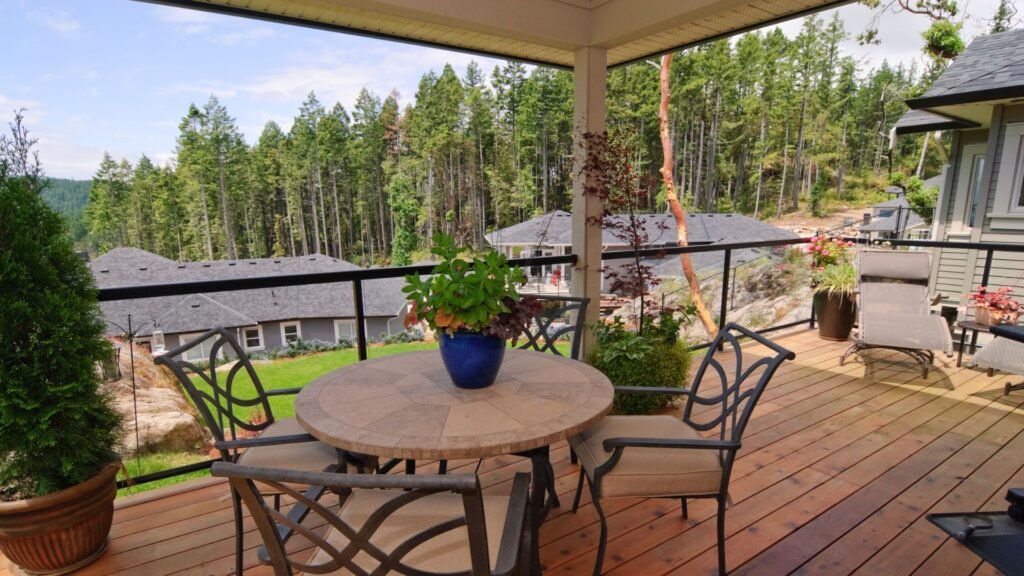
Waterproofing And Weatherproofing Tips
When building a deck with a roof in New Zealand, ensuring that your structure is well-protected from the elements is crucial. The country’s diverse and often unpredictable weather can take a toll on outdoor constructions, especially decks that are exposed to rain, wind, and varying temperatures throughout the year. By applying proper waterproofing and weatherproofing techniques, you can extend the life of your deck and roof while maintaining its structural integrity. Below are essential tips to help safeguard your investment.
Ensuring Weather Resistance
One of the most important aspects of building a deck with a roof is ensuring that both the deck itself and the roof are fully weather-resistant. New Zealand’s climate, which ranges from humid coastal areas to cooler inland regions, demands that your materials and techniques are up to the challenge.
For the deck, you should begin by selecting materials that are specifically treated for outdoor use. Pressure-treated timber is a popular choice because it is resistant to both rot and insect damage. After selecting the right materials, sealing and staining the wood will provide an additional layer of protection. Be sure to use a high-quality sealant designed to repel water while also allowing the wood to breathe. This prevents moisture from being trapped inside, which can lead to warping or rotting.
As for the roof, choosing durable materials like polycarbonate sheets or metal roofing is essential to prevent leaks and withstand heavy rainfall. A slight pitch to the roof will help water run off quickly, reducing the chances of pooling and water damage over time. Proper installation and sealing around edges and joints will also play a critical role in preventing leaks.
Protecting the Structure
To protect the overall structure of your deck, particularly in the long term, it’s essential to use materials that are resistant to moisture and corrosion. Start by using treated timber, which is designed to resist decay even in wet conditions. This is particularly important in New Zealand’s coastal regions, where salt air can accelerate the deterioration of untreated wood.
Another key consideration is the type of fasteners and hardware you use. Standard nails and screws may corrode over time when exposed to rain and humidity, leading to structural weaknesses. Instead, opt for rust-resistant fasteners such as stainless steel or hot-dipped galvanized screws and nails. These fasteners not only improve the lifespan of your deck but also help maintain its structural integrity under harsh weather conditions.
Additionally, applying a waterproof membrane between the deck and the roof structure can provide an extra layer of protection against moisture seepage. This is especially important for any flat sections or joints that may be prone to water pooling.
Adding Features Like Flashing and Guttering
A well-designed deck with a roof must also include proper flashing and guttering systems to ensure that water is efficiently directed away from the structure. Flashing, which is a thin, water-resistant material typically made from metal, is essential for sealing any gaps where the roof meets the walls or deck. Proper installation of flashing helps prevent water from penetrating the structure and causing leaks, especially around joints and edges where water is most likely to accumulate.
When installing flashing, make sure it is securely fastened and sealed along all edges. You’ll want to ensure that the flashing overlaps properly, directing water away from the structure. In areas where the roof meets a vertical wall, step flashing can be used to create a water-resistant barrier that prevents leaks along the wall.
Guttering is equally important for managing rainwater runoff. Without a well-functioning gutter system, water can overflow, causing damage to the deck, foundation, or surrounding landscape. Install gutters along the edge of the roof to catch rainwater, and use downpipes to direct it safely away from the deck and foundation. In New Zealand, where heavy rain can be a common occurrence, oversized gutters are often recommended to handle large volumes of water more effectively.
Be sure to regularly clean your gutters to prevent blockages from leaves and debris, which could lead to water backing up and overflowing. Additionally, consider installing gutter guards to reduce the amount of debris that can enter your gutters, making maintenance easier in the long run.
By incorporating these waterproofing and weatherproofing tips, you’ll ensure that your deck and roof remain protected against New Zealand’s unpredictable weather, allowing you to enjoy your outdoor space for years to come. These steps not only protect the aesthetic appeal of your deck but also improve its durability, making it a long-lasting addition to your home.
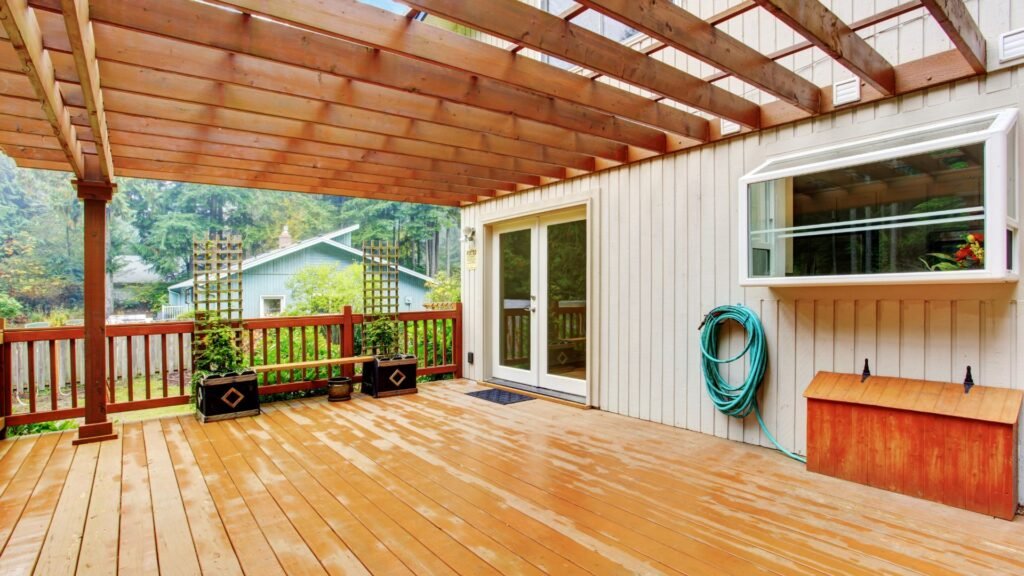
Optional Features To Enhance Your Deck
Building a deck with a roof offers a functional outdoor space, but adding thoughtful features can transform it into a true extension of your home. By incorporating elements like lighting, heating, stylish furniture, and eco-friendly choices, you can make the most of your deck all year round. Here are some optional enhancements to consider when designing your perfect outdoor area.
Lighting
One of the simplest yet most impactful ways to enhance your deck is by adding outdoor lighting. With the right lighting, you can create a warm, inviting atmosphere that makes the deck usable long after the sun sets. Options range from practical to decorative, depending on your needs.
- Overhead Lighting: Installing overhead lights, such as pendant lights or recessed ceiling lights, can illuminate the entire deck area evenly. This is ideal for decks with roofs, providing ample light for dining or entertaining at night. Make sure to use weather-resistant fixtures that can withstand New Zealand’s changing climate.
- Ambient Lighting: For a softer, more relaxed vibe, consider adding ambient lighting such as string lights, lanterns, or solar-powered LED lights. These options are energy-efficient and easy to install, offering a decorative touch while enhancing safety and visibility.
- Task Lighting: If you have specific areas where more light is needed, such as near a BBQ or outdoor kitchen, task lighting like spotlights or adjustable LED lamps can be a great addition. These focused lights ensure that you’re not working in the dark, improving functionality without compromising style.
Heating
To maximize the use of your deck throughout the year, especially during cooler months, consider adding a heating solution. Outdoor heaters and fire pits are popular choices that provide warmth and ambiance, making your deck a cozy spot even in winter.
- Outdoor Heaters: Electric patio heaters, gas heaters, or infrared heating units are all effective ways to keep your deck warm when temperatures drop. They come in various designs, including wall-mounted, freestanding, or tabletop models, allowing you to choose one that best fits your space and aesthetic.
- Fire Pits: For a more rustic or social vibe, a fire pit can be a fantastic addition to your deck. Whether built-in or portable, fire pits provide warmth and create a central gathering point where friends and family can relax. Just ensure that the fire pit is placed safely away from the roof and any flammable materials to prevent accidents.
Furniture and Décor
Choosing the right furniture and décor is crucial for turning your deck into a welcoming outdoor retreat. Your deck’s purpose—whether it’s for dining, lounging, or entertaining—will dictate your furniture choices, but the goal should always be comfort, style, and functionality.
- Outdoor Furniture: Opt for durable, weather-resistant materials like teak, aluminum, or resin wicker that can withstand New Zealand’s outdoor conditions. Comfortable seating is key; consider sofas, cushioned chairs, or even hammocks for a laid-back vibe. If you plan to use the deck for meals, invest in a sturdy outdoor dining set. Add extra touches like throw pillows and blankets to make the space feel cozy and inviting.
- Potted Plants and Greenery: Bring life to your deck by adding potted plants, hanging baskets, or vertical gardens. Native New Zealand plants like ferns, grasses, or hebes are great low-maintenance options that thrive outdoors. This not only adds beauty and texture to the space but also enhances the natural connection between your home and the surrounding landscape.
- Outdoor Rugs and Décor: Soft furnishings such as outdoor rugs can define different areas of your deck and add a splash of color or texture. Look for weatherproof rugs and cushions that are easy to clean. Additionally, decorative items like lanterns, wall art, or sculptures can bring personality to your outdoor space, making it a reflection of your style.
Sustainability Tips
If you’re conscious about reducing your environmental footprint, there are several ways to make your deck more sustainable without sacrificing comfort or design.
- Eco-Friendly Materials: When building or updating your deck, consider using sustainable materials. For decking, composite materials made from recycled wood and plastic are a popular option, as they require less maintenance and have a longer lifespan than traditional timber. If you prefer the look and feel of natural wood, opt for sustainably sourced timber certified by organizations like the Forest Stewardship Council (FSC).
- Energy-Efficient Lighting: Incorporating energy-efficient lighting solutions, such as solar-powered lights or LED bulbs, can significantly reduce energy consumption while still creating a well-lit and attractive outdoor space. Solar-powered garden lights are ideal for lining walkways or highlighting garden features, while LED bulbs can be used in overhead fixtures for long-lasting and cost-effective illumination.
- Water Conservation: If your deck includes plants, be mindful of water usage by installing drip irrigation systems or using drought-tolerant, native plants that require minimal watering. This will not only conserve water but also make your garden easier to maintain.
By considering these optional features, you can turn a simple deck into a multi-functional outdoor living area that fits your lifestyle and enhances the value of your home. Whether you’re after comfort, style, or sustainability, these enhancements will make your deck a favorite spot year-round.

Maintenance Tips For Long-Term Durability
Building a deck with a roof is an investment that adds both beauty and functionality to your home. However, to ensure it stays in top condition for years to come, regular maintenance is essential. A well-maintained deck not only looks good but also retains its structural integrity, ensuring it withstands the effects of weather, moisture, and everyday use. Below, we dive into key maintenance tips that will help you preserve your deck and roof over the long term.
Routine Cleaning
One of the most important things you can do to maintain your deck and roof is regular cleaning. Dirt, debris, and moisture can quickly accumulate, leading to mold, mildew, and even structural damage if left unattended. For the deck surface, start by sweeping off leaves, dirt, and other debris that might trap moisture. This simple task can prevent issues like wood rot and warping.
When it comes to a deeper clean, power washing is an effective way to remove stubborn dirt and grime. If you opt for power washing, make sure to use the correct pressure settings to avoid damaging the timber. For most decks, a pressure setting of 500-600 psi is sufficient. After cleaning, it’s important to allow the deck to dry thoroughly before sealing or staining to avoid trapping moisture.
For the roof, especially if it’s made from polycarbonate or metal, regularly cleaning it with a hose and mild detergent helps prevent the buildup of dirt, leaves, and algae. Be mindful of the gutters as well, as clogged gutters can cause water to pool on the roof, leading to leaks or even structural damage over time.
Inspecting for Damage
Regular inspections are crucial to catch any potential damage before it becomes a bigger problem. Every few months, take some time to check your deck for signs of wear and tear. Start with the deck boards, looking for any cracks, splinters, or warping that might have occurred due to moisture or temperature changes. If your deck is made of timber, pay particular attention to areas near the ground or places where water may pool, as these are more prone to rotting.
Don’t forget to inspect the roof structure as well. Check for any loose or missing screws, rust spots on metal roofing, or cracks in polycarbonate sheets. Make sure the roof is still securely attached to the frame and that there are no gaps where water could seep through. If your deck roof has gutters, check for blockages and make sure water is being directed away from the deck to prevent water damage.
Additionally, pest inspections should not be overlooked, particularly in timber decks. Termites and other insects can cause serious damage if left unchecked. Look for small holes in the wood or sawdust-like residue, which could indicate an infestation. If you spot any signs of pests, it’s best to call in a professional exterminator promptly to avoid further damage.
Re-staining or Painting
One of the most effective ways to extend the life of your deck is by re-staining or painting it every few years. This not only improves its appearance but also protects the wood from the elements. Sun, rain, and fluctuating temperatures can wear down the protective layers of stain or paint, leaving the wood exposed and vulnerable to damage.
When re-staining your deck, start by choosing a high-quality stain that is suited to your deck’s material. Semi-transparent stains are popular as they allow the natural grain of the wood to show through while providing solid protection. Before applying the stain, make sure the deck is clean and dry. Sand down any rough spots or splintered areas, and apply the stain evenly with a brush or roller. Two thin coats are usually recommended for optimal protection.
If your deck is painted, you’ll need to touch it up whenever the paint starts to peel or fade. Start by scraping off any loose or peeling paint, then lightly sand the surface to ensure a smooth base for the new paint. Choose exterior-grade paint designed to withstand harsh weather conditions and apply two coats for long-lasting coverage.
By maintaining a regular schedule of re-staining or painting, you’ll not only keep your deck looking its best but also ensure it’s well-protected against moisture, UV rays, and general wear and tear.
Regular maintenance of your deck and roof ensures that they stay functional, safe, and visually appealing for years. From routine cleaning to thorough inspections and timely re-staining or painting, these small efforts can prevent costly repairs down the line and keep your outdoor space looking great. A well-maintained deck with a roof is a valuable asset that you and your family can enjoy for many years to come.
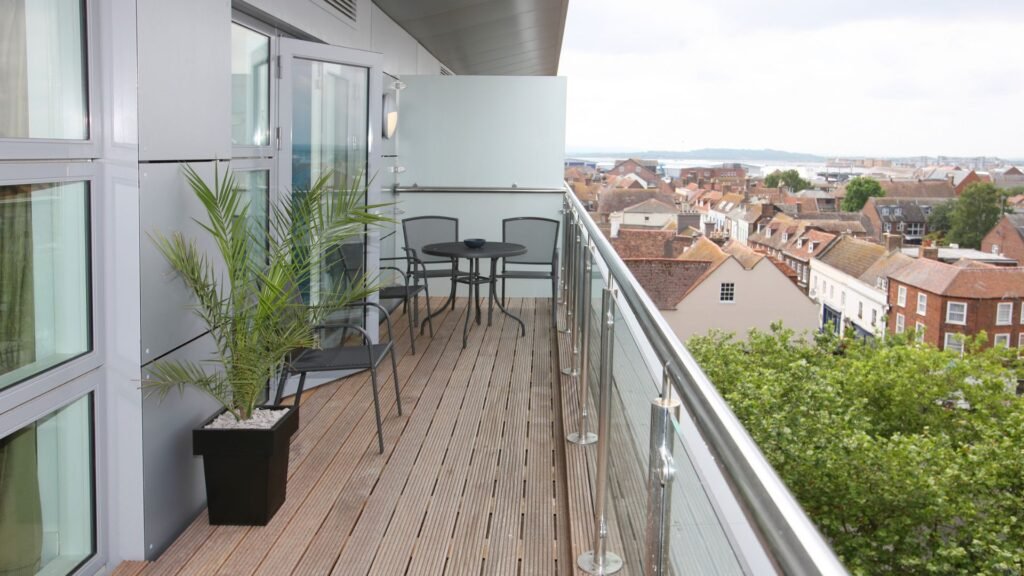
Hiring A Professional Vs. DIY
Building a deck with a roof can be a rewarding project, but it’s essential to evaluate whether to take the DIY route or hire a professional. Both options come with their advantages and challenges, and the choice largely depends on your skill level, the complexity of the project, and the time you have available. In this section, we’ll guide you through the considerations to help you make an informed decision.
When to Consider DIY
If you have some hands-on experience with construction projects and the design of your deck is straightforward, a DIY approach could be a great way to save money and add a personal touch to your home. Building your own deck can be an enjoyable weekend project for those who have basic carpentry skills and the necessary tools, such as a saw, drill, and level. Simple designs, such as a small deck with a flat roof, are often manageable for DIY enthusiasts.
However, it’s crucial to be realistic about your capabilities. If you’re unfamiliar with local building codes, permits, or structural requirements, it might be worth consulting a professional, even if you plan to do the bulk of the work yourself. DIY projects can quickly become overwhelming if the design becomes more complex than anticipated, especially when it comes to ensuring the structural integrity of both the deck and the roof.
Another thing to consider is time. While DIY might save on labor costs, building a deck and roof is time-consuming. Be prepared to commit a few weekends (or longer, depending on the weather and complexity) to get the job done right.
When to Hire a Professional
For larger, more complex projects, or when the landscape of your property is challenging, hiring a professional builder is highly recommended. A professional can help you navigate New Zealand’s building regulations, ensuring your deck complies with safety standards, especially when it’s over a certain height or includes a roof structure that requires additional engineering.
Hiring a professional is particularly beneficial if your deck includes custom features, multiple levels, or intricate roofing designs like gable or skillion roofs. These elements often require advanced carpentry skills and a deep understanding of load-bearing structures. In these cases, the expertise of a builder can ensure the project is completed to a high standard and within legal requirements. Additionally, professionals have access to better tools and materials, which can improve the durability and appearance of the final structure.
Safety is another significant consideration. Building a deck with a roof involves heavy materials and precise measurements. Mistakes during construction can lead to structural weaknesses, which can pose serious safety hazards. A licensed builder ensures that your deck and roof are built to last and can withstand New Zealand’s sometimes harsh weather conditions.
How to Choose a Professional
If you decide to hire a builder, choosing the right professional is crucial. Start by researching builders in your local area and checking for certifications and qualifications. In New Zealand, it’s important to hire a licensed building practitioner (LBP) for projects that require building consents, as they are certified by the government to meet high standards of workmanship and safety.
Ask for recommendations from friends, family, or neighbors who have had similar projects done. Word-of-mouth recommendations are often the best way to find a reliable builder who understands the specific needs of your area. Online reviews and ratings can also provide insight into a builder’s reputation.
Before committing, ask potential builders for examples of past work. A reputable builder should have a portfolio of previous deck and roof projects that showcase their skills and style. Viewing past work can help you decide if their craftsmanship aligns with your vision. Additionally, don’t hesitate to ask for references from previous clients to hear firsthand about their experience with the builder.
Finally, make sure to get a clear, written contract that outlines the scope of work, timeline, costs, and any warranties provided. A detailed contract protects both you and the builder, ensuring that expectations are clear and that the project proceeds smoothly.
Deciding between DIY and hiring a professional depends on the complexity of your deck project, your skill level, and the time you have available. For simple projects, DIY can be a rewarding way to create your outdoor space. However, for more complex designs or if you lack the necessary skills, hiring a professional will ensure the job is done safely and to a high standard.

FAQs: About How To Build A Deck With Roof NZ
How much does it cost to build a deck with a roof in New Zealand?
The cost of building a deck with a roof in New Zealand varies depending on the size, materials used, and whether you hire a professional or do it yourself. On average, building a deck can cost between NZD $300 and $600 per square meter, with additional costs for roofing, permits, and labor if hiring professionals. A roof may add another NZD $1,000 to $5,000 depending on materials and design.
Do I need a building permit to build a deck with a roof in New Zealand?
Yes, in most cases, you will need a building consent to construct a deck with a roof in New Zealand. It’s important to check with your local council to understand the specific regulations and whether your deck falls within the guidelines for requiring a permit. A deck over 1.5 meters in height or one with a permanent roof structure will typically need consent.
What are the best materials for building a deck in New Zealand?
Treated timber, such as pine, is one of the most popular decking materials in New Zealand due to its affordability, durability, and resistance to rot. Other high-quality options include hardwoods like Kwila or composite decking, which offer longevity and low maintenance. For the roof, options such as polycarbonate panels or metal sheeting are common due to their durability and ability to withstand harsh weather.
Can I build a deck with a roof myself, or should I hire a professional?
If you have some construction experience and the deck is relatively straightforward, building it yourself is possible. However, more complex designs, large decks, or those requiring detailed structural work may be best left to professionals, especially since ensuring compliance with local building codes is crucial. Hiring a professional also ensures a higher level of workmanship and safety.
What style of roof is best for a deck in New Zealand’s climate?
For New Zealand’s varied weather, a pitched roof such as a gable or skillion roof is recommended because it allows rainwater to easily run off, reducing the risk of water pooling or damage. Polycarbonate or metal roofing materials are common because they are durable, lightweight, and weather-resistant.
How do I maintain my deck and roof over time?
To maintain your deck and roof, regularly clean both surfaces to remove debris, mold, and mildew. Timber decks should be re-stained or sealed every 1-2 years, while roofs, especially those made from metal or polycarbonate, should be inspected for rust or damage. It’s also important to check that gutters and downpipes are clear to prevent water damage.
How long does it take to build a deck with a roof?
The time it takes to build a deck with a roof depends on factors such as size, complexity, and whether you’re building it yourself or hiring a professional. A simple DIY deck might take a few weekends, while a professional construction could take 1-2 weeks depending on weather and material availability.
How do I ensure my deck and roof meet New Zealand safety regulations?
To ensure your deck and roof meet New Zealand safety regulations, consult the New Zealand Building Code and local council requirements. You’ll need to comply with rules regarding the deck’s height, handrails, footings, and roofing structure. If you’re unsure, hiring a licensed building practitioner (LBP) ensures your project complies with all necessary standards.
What is the lifespan of a deck with a roof in New Zealand?
With proper care and maintenance, a deck with a roof in New Zealand can last anywhere from 15 to 30 years or more, depending on the materials used. Treated timber decks that are regularly stained or sealed, and roofs made from durable materials like metal or polycarbonate, will have the longest lifespan.
Can I add features like lighting or heating to my deck with a roof?
Yes, adding features like lighting, heating, or even outdoor kitchens can enhance your deck’s functionality. For lighting, consider energy-efficient options like LED or solar-powered lights. For heating, electric patio heaters or gas-fueled outdoor fireplaces are common choices. Ensure that all electrical installations comply with safety standards and are performed by a qualified electrician.
Conclusion
In conclusion, building a deck with a roof in New Zealand requires careful planning, adherence to local building codes, and thoughtful design choices to ensure a functional and aesthetically pleasing result. From securing permits and selecting the right materials (Building Consent Requirements in New Zealand) to constructing a solid foundation and installing a durable roof, each step plays a crucial role in the success of the project. By following the outlined steps, you can create a versatile outdoor space that adds value to your home and enhances your lifestyle, providing shelter and comfort in various weather conditions. It’s important to take your time with each phase, ensuring attention to detail and safety. If you’ve built a deck with a roof or are planning to, we’d love to hear about your experiences—feel free to share in the comments below! For those seeking more in-depth guidance or professional assistance, explore the additional resources provided or consider reaching out to a qualified expert to ensure the best outcome for your project.
About the Author:
Mike Veail is a recognized digital marketing expert with over 6 years of experience in helping tradespeople and small businesses thrive online. A former quantity surveyor, Mike combines deep industry knowledge with hands-on expertise in SEO and Google Ads. His marketing strategies are tailored to the specific needs of the trades sector, helping businesses increase visibility and generate more leads through proven, ethical methods.
Mike has successfully partnered with numerous companies, establishing a track record of delivering measurable results. His work has been featured across various platforms that showcase his expertise in lead generation and online marketing for the trades sector.
Learn more about Mike's experience and services at https://theleadguy.online or follow him on social media:




